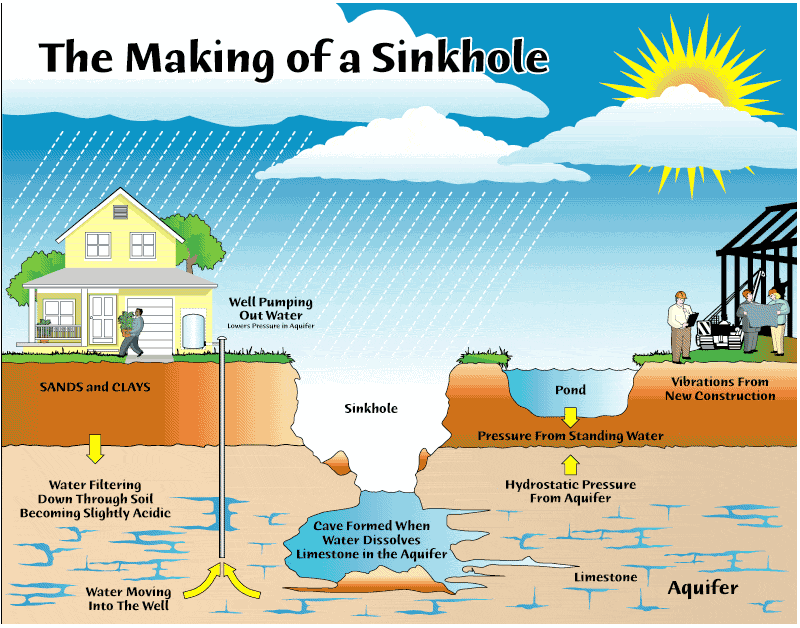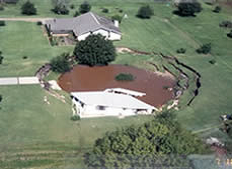SINKHOLE INFORMATION FOR MARION COUNTY RESIDENTS
Sinkholes are a common naturally occurring geologic phenomenon and one of the predominant land forms in Florida. Many of the lakes in Florida are relic sinkholes. They are typically circular but can develop in other shapes depending on the soils and geology. Sinkholes can be classified as geologic hazards sometimes causing extensive damage to structures and roads resulting in costly repairs. Sinkholes can also threaten water supplies by draining unfiltered water from streams, lakes and wetlands directly into the aquifer (underground water supply).
Some of the most asked questions about sinkholes are:
What is a sinkhole?
Sinkholes are depressions or holes in the land surface that occur throughout central Florida. They can be shallow or deep, small or large, but all are a result of the dissolving of the underlying limestone. Hydrologic conditions, including lack of rainfall, lowered water levels, or, conversely, excessive rainfall in a short period of time, can all contribute to sinkhole development.
What does a Sinkhole look like?
Sinkholes can come in many different sizes and shapes. They range from shallow depressions a few inches deep and several feet across to giants that can swallow multiple houses. The sides of the sinkhole may be gently sloping or they may be vertical. There are generally three types of sinkholes.
- Limestone Solution Sinkholes – Within Marion County, limestone is exposed at the surface or is covered by a thin layer of soil. This leaves the limestone subject to both physical and chemical processes that break down the rock. When this breakdown occurs, it usually forms a saucer or bowl-shaped depression. Due to the natural dissolving of limestone, these sinkholes develop continuously, but slowly.
- Cover-Subsidence Sinkholes - Where the sand layer may be as thick as 50 to 100 feet, with very little clay below it, the dissolving limestone is replaced by granules of sand that cascade down to fill the void. This type of sinkhole is referred to as a cover-subsidence sinkhole. These sinkholes are only a few feet in diameter and depth. Their small size is due to the fact that the cavities in the limestone cannot develop to appreciable size before they are filled with sand.
- Cover-Collapse Sinkholes - Generally, the deeper the soils, more clay is present in the soils. This clay provides some cohesiveness to the soil material above it, allowing it to bridge an existing cavity in the limestone. If this "bridge" collapses, it results in what is called a cover-collapse sinkhole. See the graphic above. The size of the sinkhole depends upon the size of the cavity. Cover collapse sinkholes form the same way as cover-subsidence sinkholes but differ mainly in the bearing strength of the soil above the cavity and whether the sinkhole subsides slowly or collapses abruptly.
What can cause a Sinkhole to form?
Rainfall absorbs carbon dioxide and reacts with decaying vegetation, creating slightly acidic water. When this water reaches the limestone aquifer, it moves through spaces and cracks slowly dissolving the limestone and creating a network of cavities and voids. As the limestone dissolves, pores and cracks are enlarged and carry even more acidic water. Water not only contributes to the chemical dissolving of the limestone but it also affects the support or lack of support provided to a cavity when the water level changes. A sinkhole is formed when the land surface above a cavity collapses or sinks into the cavity or when surface materials are carried downward into the voids.
A natural drought or the pumping too much groundwater can leave underground cavities empty. This can make conditions favorable for sinkholes to form. Also, heavy rains following a drought often cause enough pressure on the ground to create sinkholes.
Sinkholes can be triggered by human activities such as:
- Over pumping of groundwater
- Diverting surface water from a large area and concentrating it in a smaller area
- Artificially creating ponds of surface water
- Drilling new water wells
- Construction of roadways or structures
Sinkholes are hazardous because they can destroy highways and buildings. Sinkholes also can cause water quality problems. During a collapse, surface waters may leak into the aquifer, our underground source of drinking water.
Where do Sinkholes occur?
Sinkholes can occur in all parts of Marion County although some areas are more prone to sinkhole than others.
What are Sinkhole warning signs?
Fresh exposures on fence posts, foundations or trees that result when the ground sinks around them or slumping, sagging or slanting fence posts, trees or other objects.


